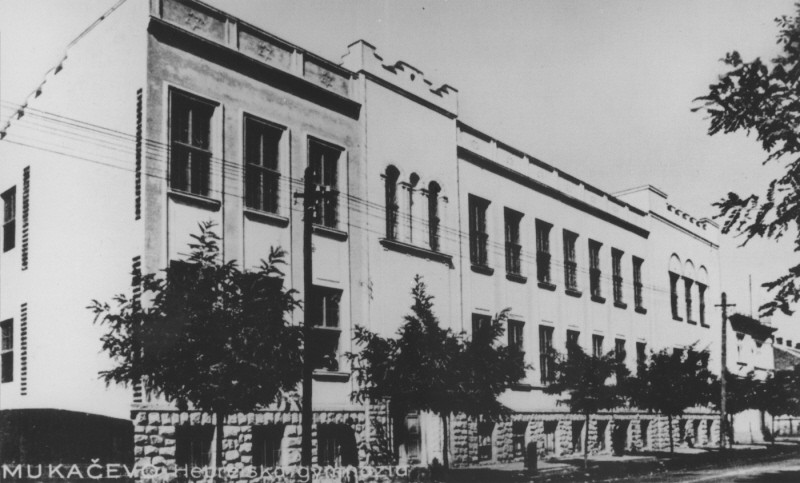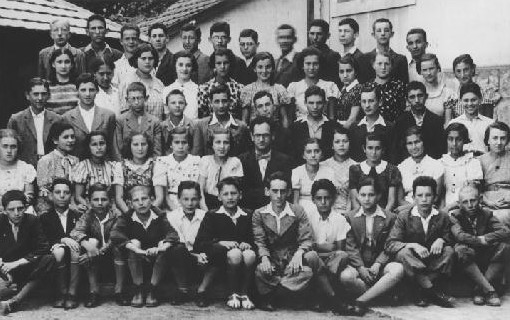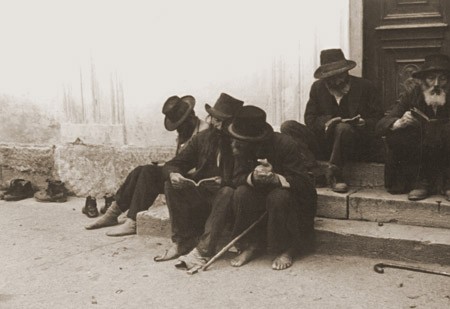
Jewish Community Life in Munkacs
Political Life
Jewish communal life and politics in Munkacs between World War I and World War II were dominated by the imposing presence of Rabbi Hayyim Eleazar Shapira, the leader of the Munkacs Hasidim and chief rabbi of Munkacs. Rabbi Shapira led a fierce and successful campaign to force Rabbi Issachar Dov Rokeah, the leader of the Belzer Hasidim, out of Munkacs. Rokeah had fled to Munkacs from Belz, Poland, during World War I.
Rabbi Shapira also opposed the Zionism of the Jewish Party of Czechoslovakia and the Agudah (Orthodox Jewish political party) of Slovakia for its willingness to compromise with more secular Jews and Zionists. As a result, he allied with the nationalist, non-Jewish Agrarian Party, which was interested in the votes of his followers, in order to fight the Jewish Party and maintain a more traditional Jewish life. The Jewish Party nonetheless received a great deal of support from the Jews of Munkacs.
Rabbi Shapira fought the small but influential Zionist organization in Munkacs, and especially the modern Hebrew-language school that it founded in the 1920s. He banned assistance of any form to the Zionists, whom he called "heretics and atheists," and predicted that Jews who sent their children to the Hebrew school, the "house of abomination," would be "wiped out." The school sued him and eventually won. He was sentenced to "a fine of 1000 Korunas [crowns] or twenty days in prison" (Dicker, Piety and Perseverance, p. 53). In 1927, a secessionary Neolog (Reform) community was founded in Munkacs. Condemned by Shapira, it lasted only six years.
In addition to his political and communal activities, Rabbi Shapira served as spiritual leader to his flock, headed the Munkacs yeshiva, and wrote a number of Talmudic commentaries.
Acculturation in Subcarpathian Rus
In Subcarpathian Rus, there was no obvious dominant majority culture or language, as in other regions of Czechoslovakia and some other countries in eastern Europe. While most Jews continued to speak Yiddish at home, those who wished to send their children to modern schools instead of the traditional heder could choose between Ukrainian, Czech, Hungarian, and Hebrew educational systems.
Some lower and middle-class Jews sent their children to Ukrainian schools so they would learn the local language, and in the 1930s other Jews began to send their children to Czech-language, public Jewish schools. Some Jewish families continued to have their children educated in Hungarian schools, a legacy of the acculturation that many Jews had embraced in Hungary during the reign of the Habsburg monarchs.

Although some Czech Jews characterized themselves as "national" Jews and even Zionists, most were deeply assimilated into Czech or German cultures. Only in Subcarpathian Rus were Hebrew-language Zionist schools established and made viable, including one gymnasium (high school) in Munkacs. Chaim Kugel, director of this school, was a leader of the Czechoslovak Jewish Party and was elected to the national parliament in 1935. The national government, though officially committed to Jewish cultural autonomy, did not at first support the Zionist schools, though the Czechoslovak President Thomas Masaryk made a show of support by giving a personal donation in the amount of 10,000 crowns.
Zionism in Munkacs
Zionism came relatively late to Munkacs; the first Zionist group was founded in the town in 1912. The Zionist Hebrew-language elementary school was founded in 1920, and the high school in 1926. By the time of its first graduation in 1932, it had 232 students. Though few in number, Munkacs' Zionists took an active role in Jewish social and cultural affairs. After a branch of the religious Zionist organization "Mizrahi" was established in the town, Zionism made inroads into the Orthodox and Hasidic communities as well.
Munkacs became a Zionist center for all of Subcarpathian Rus, and its Hebrew schools were the model for those founded in other towns in the region. It was thus no accident that the national Zionist organization chose Subcarpathian Rus as the site for its Hebrew-language summer camps. Moreover, graduates of the Munkacs Hebrew high school went on to become active Zionist university students and Hebrew teachers throughout Czechoslovakia.
Through the influence of the Jewish representatives on the Munkacs town council, the Zionists had the main Jewish street, on which were situated most of the Jewish institutions, officially renamed "Judah ha-Levi Street" (after the medieval Spanish-Jewish philosopher). The followers of the Munkacs Rebbe then successfully petitioned to have it renamed again, this time to "Ways of Repentance Street" (after the Munkacs yeshiva of the same name). Another street was named after the well-known Hebrew poet Hayim Nahman Bialik.
Communal Organizations

The town's very strong Jewish presence was most visible on the Sabbath. On this day, most stores were closed and, after services, the streets filled with Hasidic Jews in their traditional garb.
There were three weekly Jewish newspapers in Munkacs, all in Yiddish: the Zionist Yidishe shtime (Jewish Voice); Yidishes folks-blat (Jewish People's Paper), noted for its opposition to the Munkacs Rebbe and for its Zionist leanings; and Yidishe tsaytung (Jewish Newspaper), the official organ of the Munkacs Hasidim. There was also a weekly humor magazine called Der Humorist.
In addition to the Hasidic yeshiva with over 200 students, Munkacs boasted 15 other houses of study. The town was home to Hasidim of many dynasties, including the leaders of the Ziditshov, Spinka, and Dolina Hasidic groups, and many Belz and Vizhnitz Hasidim. Each sect had its own synagogue and its own customs. Many of the different sects forbade marriages with the others and even declared each other's food non-kosher.
There were numerous Jewish communal organizations, including study groups, associations to provide for the education of the poor, organizations to help the poor and the sick, a Free Loan Society, and a Jewish hospital. The JDC operated a loan bank, an orphanage, and a vocational school for girls.
Critical Thinking Questions
- Learn about the history of the Jewish community in your country.

